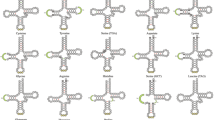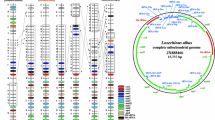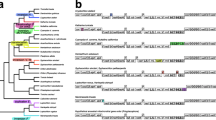Abstract
Molecular characters may offer a useful alternative to confidently estimate the phylogenetic position of paedomorphic taxa otherwise difficult to place based on morphology because of the reduction or absence of characters in their larvae-like adult stage. Here, we sequenced the complete mitogenome of a remarkable undescribed marine paedomorphic clupeiform fish to gain insight into its phylogenetic position. Of a length of 17,507 bp, this mitogenome exhibits a unique gene order within the Teleostei because of the inversion of the contiguous tRNAGln and tRNAIle within the IQM region and the presence of a putative second control region inserted between these tRNAs. Mitogenomic data from 27 clupeiform species and 22 non-clupeiform species were subjected to partitioned maximum likelihood and Bayesian analyses. All resultant phylogenetic trees strongly supported the placement of this undescribed taxon within the order Clupeiformes, suborder Clupeoidei, and the family Clupeidae, as the sister group of the tribe Spratelloidini (Jenkinsia + Spratelloides) of the subfamily Dussumieriinae. Together, they form a monophyletic group with Chirocentrus and, possibly, Etrumeus. Despite its overall resemblance to Sundasalanx, this undescribed taxa (Clupeidae gen. et sp. indet.) is not closely related to that genus and represents an independent paedomorphic lineage within the Clupeoidei.



Similar content being viewed by others
References
Begle DP (1991) Relationships of the osmeroid fishes and the use of reductive characters in phylogenetic analysis. Syst Zool 40:33–53
Broughton RE, Reneau PC (2006) Spatial covariation of mutation and nonsynonymous substitution rates in vertebrate mitochondrial genomes. Mol Biol Evol 23:1516–1524
Cheng S, Higuchi R, Stoneking M (1994) Complete mitochondrial genome amplification. Nat Genet 7:350–351
Costa WJEM, Le Bail PY (1999) Fluviphylax palikur: a new poeciliid from the Rio Oiapoque basin, northern Brazil (Cyprinodontiformes: Cyprinodontoidei), with comments on miniaturization in Fluviphylax and other neotropical freshwater fishes. Copeia 1999:1027–1034
Dingerkus G, Uhler LD (1977) Enzyme clearing of alcian blue stained whole small vertebrates for demonstration of cartilage. Stain Technol 52:229–232
Géry J (1964) Une nouvelle famille de poissons dulçaquicoles africains; les Grasseichthyidae. CR Acad Sci III 259:4805–4807
Grande L (1985) Recent and fossil clupeomorph fishes with materials for revision of the subgroups of clupeoids. Bull Am Mus Nat Hist 181:231–372
Hanken J, Wake DB (1993) Miniaturization of body-size—organismal consequences and evolutionary significance. Ann Rev Ecol Syst 24:501–519
Huelsenbeck JP, Ronquist F (2001) MrBAYES: Bayesian inference of phylogenetic trees. Bioinformatics 17:754–755
Inoue JG, Miya M, Tsukamoto K, Nishida M (2001) Complete mitochondrial DNA sequence of Conger myriaster (Teleostei: Anguilliformes): novel gene order for vertebrate mitochondrial genomes and the phylogenetic implications for anguilliform families. J Mol Evol 52:311–320
Inoue JG, Miya M, Tsukamoto K, Nishida M (2003) Evolution of the deep-sea gulper eel mitochondrial genomes: large-scale gene rearrangements originated within the eels. Mol Biol Evol 20:1917–1924
Inoue JG, Miya M, Tsukamoto K, Nishida M (2004) Mitogenomic evidence for the monophyly of elopomorph fishes (Teleostei) and the evolutionary origin of the leptocephalus larva. Mol Phylogenet Evol 32:274–286
Ishiguro NB, Miya M, Nishida M (2003) Basal euteleostean relationships: a mitogenomic perspective on the phylogenetic reality of the “Protacanthopterygii”. Mol Phylogenet Evol 27:476–488
Ishiguro NB, Miya M, Inoue JG, Nishida M (2005) Sundasalanx (Sundasalangidae) is a progenetic clupeiform, not a closely-related group of salangids (Osmeriformes): mitogenomic evidence. J Fish Biol 67:561–569
Johnson GD, Patterson C (1996) Relationships of lower euteleostean fishes. In: Stiassny MLJ, Parenti LR, Johnson GD (eds) Interrelationships of fishes. Academic Press, New York, pp 251–332
Kon T, Yoshino T, Mukai T, Nishida M (2007) DNA sequences identify numerous cryptic species of the vertebrate: a lesson from the gobioid fish Schindleria. Mol Phylogenet Evol 44:53–62
Kottelat M, Britz R, Hui TH, Witte KE (2006) Paedocypris, a new genus of Southeast Asian cyprinid fish with a remarkable sexual dimorphism, comprises the world’s smallest vertebrate. Proc R Soc Lond B 273:895–899
Lavoué S, Miya M, Inoue JG, Saitoh K, Ishiguro N, Nishida M (2005) Molecular systematics of the gonorynchiform fishes (Teleostei) based on whole mitogenome sequences: implications for higher-level relationships within the Otocephala. Mol Phylogenet Evol 37:165–177
Lavoué S, Miya M, Saitoh K, Ishiguro NB, Nishida M (2007) Phylogenetic relationships among anchovies, sardines, herrings and their relatives (Clupeiformes), inferred from whole mitogenome sequences. Mol Phylogenet Evol 43:1096–1105
Lee JS, Miya M, Lee YS, Kim CG, Park EH, Aoki Y, Nishida M (2001) The complete DNA sequence of the mitochondrial genome of the self-fertilizing fish Rivulus marmoratus (Cyprinodontiformes, Rivulidae) and the first description of duplication of a control region in fish. Gene 280:1–7
Li C, Ortí G (2007) Molecular phylogeny of Clupeiformes (Actinopterygii) inferred from nuclear and mitochondrial DNA sequences. Mol Phylogenet Evol 44:386–398
Löytynoja A, Milinkovitch MC (2003) A hidden Markov model for progressive multiple alignment. Bioinformatics 19:1505–1513
Mabuchi K, Miya M, Satoh TP, Westneat MW, Nishida M (2004). Gene rearrangements and evolution of tRNA pseudogenes in the mitochondrial DNA of the parrotfish (Teleostei: Perciformes: Scaridae). J Mol Evol 59:287–297
Macey JR, Larson A, Ananjeva NB, Fang ZL, Papenfuss TJ (1997) Two novel gene orders and the role of light-strand replication in rearrangement of the vertebrate mitochondrial genome. Mol Biol Evol 14:91–104
Miya M, Nishida M (1997) Speciation in the open ocean. Nature 389:803–804
Miya M, Nishida M (1999) Organization of the mitochondrial genome of a deep-sea fish, Gonostoma gracile (Teleostei: Stomiiformes): first example of transfer RNA gene rearrangements in bony fishes. Mar Biotechnol 1:416–426
Miya M, Nishida M (2000) Use of mitogenomic information in teleostean molecular phylogenetics: a tree-based exploration under the maximum-parsimony optimality criterion. Mol Phylogenet Evol 17:437–455
Miya M, Kawaguchi A, Nishida M (2001) Mitogenomic exploration of higher teleostean phylogenies: a case study for moderate-scale evolutionary genomics with 38 newly determined complete mitochondrial DNA sequences. Mol Biol Evol 18:1993–2009
Miya M, Takeshima H, Endo H, Ishiguro NB, Inoue JG, Mukai T, Satoh TP, Yamaguchi M, Kawaguchi A, Mabuchi K, Shirai SM, Nishida M (2003) Major patterns of higher teleostean phylogenies: a new perspective based on 100 complete mitochondrial DNA sequences. Mol Phylogenet Evol 26:121–138
Miya M, Satoh TP, Nishida M (2005) The phylogenetic position of toadfishes (order Batrachoidiformes) in the higher ray-finned fish as inferred from partitioned Bayesian analysis of 102 whole mitochondrial genome sequences. Biol J Linn Soc 85:289–306
Moritz C, Dowling TE, Brown WM (1987) Evolution of animal mitochondrial DNA—relevance for population biology and systematics. Ann Rev Ecol Syst 18:269–292
Phillips MJ, Delsuc F, Penny D (2004) Genome-scale phylogeny and the detection of systematic biases. Mol Biol Evol 21:1455–1458
Posada D, Crandall KA (1998) MODELTEST: testing the model of DNA substitution. Bioinformatics 14:817–818
Roberts TR (1981) Sundasalangidae, a new family of minute freshwater salmoniform fishes from Southeast Asia. Proc Calif Acad Sci 42:295–302
Roberts TR (1984) Amazonsprattus scintilla, new genus and species from the Rio Negro, Brazil, the smallest known clupeomorph fish. Proc Calif Acad Sci 43:317–321
Ronquist F, Huelsenbeck JP (2003) MrBayes 3: Bayesian phylogenetic inference under mixed models. Bioinformatics 19:1572–1574
Saitoh K, Sado T, Mayden RL, Hanzawa N, Nakamura K, Nishida M, Miya M (2006) Mitogenomic evolution and interrelationships of the Cypriniformes (Actinopterygii: Ostariophysi): the first evidence toward resolution of higher-level relationships of the world’s largest freshwater fish clade based on 59 whole mitogenome sequences. J Mol Evol 63:826–841
Satoh TP, Miya M, Endo H, Nishida M (2006) Round and pointed-head grenadier fishes (Actinopterygii: Gadiformes) represent a single sister group: evidence from the complete mitochondrial genome sequences. Mol Phylogenet Evol 40:129–138
Siebert DJ (1997) Notes on the anatomy and relationships of Sundasalanx Roberts (Teleostei, Clupeidae), with descriptions of four new species from Borneo. Bull Br Mus (Nat Hist) Zool 63:13–26
Stamatakis A (2006) RAxML-VI-HPC: maximum likelihood-based phylogenetic analyses with thousands of taxa and mixed models. Bioinformatics 22:2688–2690
Sullivan JP, Lavoué S, Hopkins CD (2002) Discovery and phylogenetic analysis of a riverine species flock of African electric fishes (Mormyridae: Teleostei). Evolution 56:597–616
Taylor WR (1967) An enzyme method of clearing and staining small vertebrates. Proc US Nat Mus 122:1–17
Tzeng CS, Hui CF, Shen SC, Huang PC (1992) The complete nucleotide-sequence of the Crossostoma Lacustre mitochondrial genome—conservation and variations among vertebrates. Nucleic Acids Res 20:4853–4858
Whitehead PJP (1963) A contribution to the classification of clupeoid fishes. Ann Mag Nat Hist 5:737–750
Yamanoue Y, Miya M, Matsuura K, Katoh M, Sakai H, Nishida M (2004) Mitochondrial genomes and phylogeny of the ocean sunfishes (Tetraodontiformes: Molidae). Ichthyol Res 51:269–273
Yang Z (1994) Maximum likelihood phylogenetic estimation from DNA sequences with variable rates over sites: approximate methods. J Mol Evol 39:306–314
Acknowledgments
This study was supported by research grants nos. 16570082, 15380131, 17207007 and 19207007 from the Japan Society for the Promotion of Science. SL was supported by a postdoctoral fellowship “Lavoisier-Japon” of the French Foreign Ministry. We specially thank Mr. Jonathaniel Apurado for his help in collection of the specimens. We also thank Drs. Takashi P. Satoh, Ryouka Kawahara, Takeshi Kon, Kohji Mabuchi and Yusuke Yamanoue for their assistance in the laboratory work and fruitful discussion. Neil Aschliman kindly commented an early version of this manuscript. We finally thank Misako Seimiya for her greatly appreciated help in the administrative part of this work. Any experiments in this study complied with the current laws of Japan in which they were performed.
Author information
Authors and Affiliations
Corresponding author
Electronic supplementary material
Below is the link to the electronic supplementary material.
About this article
Cite this article
Lavoué, S., Miya, M., Kawaguchi, A. et al. The phylogenetic position of an undescribed paedomorphic clupeiform taxon: mitogenomic evidence. Ichthyol Res 55, 328–334 (2008). https://doi.org/10.1007/s10228-008-0044-3
Received:
Revised:
Accepted:
Published:
Issue Date:
DOI: https://doi.org/10.1007/s10228-008-0044-3




